
Trillium is a genus of about fifty flowering plant species in the family Melanthiaceae. Trillium species are native to temperate regions of North America and Asia, with the greatest diversity of species found in the southern Appalachian Mountains in the southeastern United States.
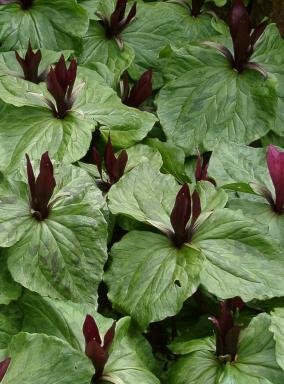
Trillium chloropetalum, also known as giant trillium, giant wakerobin, or common trillium, is a species of flowering plant in the family Melanthiaceae. It is endemic to the western U.S. state of California, being especially frequent in and around the San Francisco Bay Area.

Trillium erectum, the red trillium, also known as wake robin, purple trillium, bethroot, or stinking benjamin, is a species of flowering plant in the family Melanthiaceae. The plant takes its common name "wake robin" by analogy with the European robin, which has a red breast heralding spring. Likewise Trillium erectum is a spring ephemeral plant whose life-cycle is synchronized with that of the forests in which it lives. It is native to the eastern United States and eastern Canada from northern Georgia to Quebec and New Brunswick.
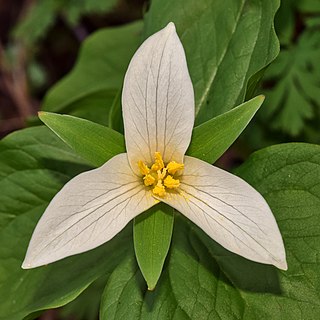
Trillium ovatum, the Pacific trillium, also known as the western wakerobin, western white trillium, or western trillium, is a species of flowering plant in the family Melanthiaceae. It is the most widespread and abundant trillium in western North America. Its type specimen was gathered by Meriwether Lewis during the return trip of the Lewis and Clark Expedition in 1806.

Trillium luteum, the yellow trillium or yellow wakerobin, is a species of flowering plant in the bunchflower family Melanthiaceae. It is a member of the Trillium cuneatum complex, a closely related group of sessile-flowered trilliums. The species is endemic to the southeastern United States, especially in and around the Great Smoky Mountains of eastern Tennessee and western North Carolina.

Trillium rugelii is a species of flowering plant in the family Melanthiaceae. It is endemic to the southeastern United States. Its white flower is typically found nodding beneath the leaves, hence it is known as the southern nodding trillium. The specific epithet rugelii honors Ferdinand Rugel, a botanist and plant collector who collected plant specimens throughout the southeastern U.S. during the period 1840–1848. Although the species is apparently secure across its range, statewide it is vulnerable at best.

Trillium discolor, the mottled wakerobin, pale yellow trillium, or small yellow toadshade, is a species of flowering plant in the family Melanthiaceae. It is native to areas of the Savannah River drainage system of Georgia, North Carolina and South Carolina such as Steven's Creek Heritage Preserve and Lake Keowee. It is found along moist stream banks in upland woods, on acidic to basic soils.

Trillium flexipes, known as the nodding wakerobin, bent trillium, or drooping trillium, is a species of flowering plant in the family Melanthiaceae. It is found from Minnesota to Ohio, south to Tennessee, with isolated populations in New York, Pennsylvania, Alabama, and other states. It is an endangered species in Ontario and threatened in North Carolina.

Trillium viridescens, also known as the Ozark trillium or tapertip wakerobin, is a species of flowering plant in the family Melanthiaceae. It is found in parts of Arkansas, Missouri, Oklahoma, Kansas, Texas and Louisiana. It usually grows in rich deciduous forests and mountain ranges where the soil is clayey and calcareous.

Trillium vaseyi, the sweet wakerobin or sweet beth, is a spring flowering perennial plant which is found only in the southeastern United States, primarily in the southern part of the Appalachian Mountains but with a few populations farther south.

Trillium lancifolium, the lanceleaf wakerobin, lance-leaved trillium, or narrow-leaved trillium, is a species of plants native to the southeastern United States. It is known to occur in Alabama, Florida, Georgia, Mississippi, South Carolina, and Tennessee. The species is imperiled in Alabama and Florida, and critically imperiled in South Carolina and Tennessee.
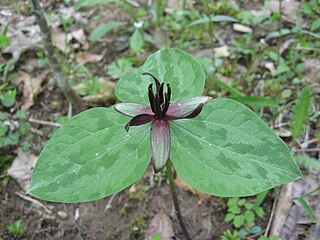
Trillium stamineum, the twisted trillium, also known as the Blue Ridge wakerobin, is a species of flowering plant in the family Melanthiaceae. It is native to the southeastern United States, in Alabama, Mississippi and Tennessee. Its natural habitat is calcareous woodlands.

Trillium sulcatum is a species of flowering plant in the bunchflower family Melanthiaceae. It is a member of the Erectum group, a group of species typified by Trillium erectum. The specific name sulcatum means "furrowed, grooved, or sulcate", which describes the tips of the sepals. It is most abundant on the Cumberland Plateau in central Tennessee and eastern Kentucky where it blooms in April and May. The species is commonly known as the southern red trillium or furrowed wakerobin.
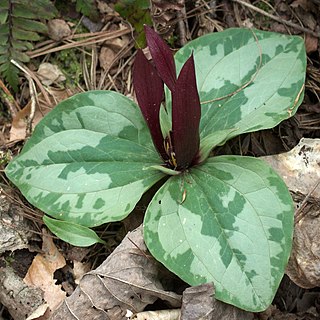
Trillium decumbens, also known as the decumbent trillium or trailing wakerobin, is a species of flowering plant in the bunchflower family (Melanthiaceae). It is native to the southeastern United States, specifically Tennessee, Georgia, and Alabama, where it grows in mature deciduous woodlands or on open rocky wooded slopes.

Trillium pusillum is a species of flowering plant in the family Melanthiaceae known by the common names dwarf trillium, least trillium and dwarf wakerobin. It is native to the southeastern and south-central United States from Oklahoma to Maryland.

Trillium foetidissimum, also known as the Mississippi River wakerobin, stinking trillium, or fetid trillium, is a species of flowering plant in the family Melanthiaceae. It is found along the Louisiana–Mississippi border in a variety of habitats.
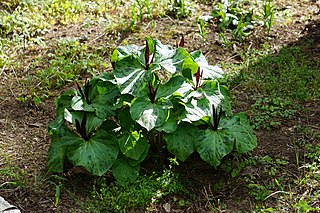
Trillium angustipetalum, with the common name is narrowpetal wakerobin, is a species of Trillium, plants which may be included within the Liliaceae or the newer family Melanthiaceae.
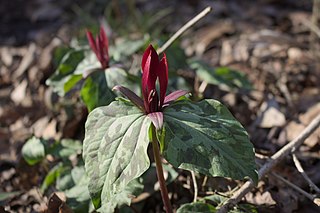
Trillium maculatum, the spotted wakerobin or spotted trillium, is a species of flowering plant in the family Melanthiaceae. It is a member of the Trillium cuneatum complex, a closely related group of sessile-flowered trilliums. The species is endemic to the southeastern United States, ranging across Alabama, Georgia, South Carolina, and northern Florida.
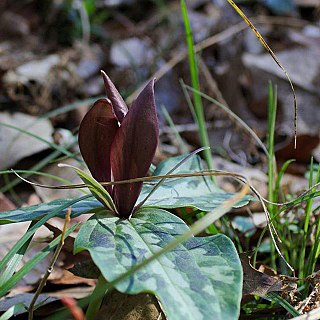
Trillium underwoodii, the longbract wakerobin, is a plant species found only in the southeastern United States.

Trillium texanum, the Texas trillium or Texas wakerobin, is a species of flowering plant in the family Melanthiaceae. It is found in east Texas, extreme southwestern Arkansas, and extreme northwestern Louisiana. Due to its limited range, it is designated as a vulnerable species.




















